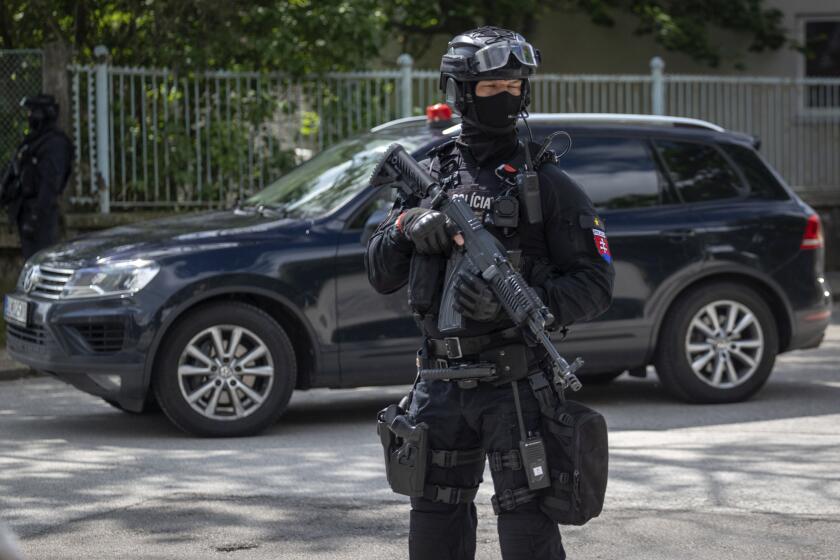Bittersweet Days for France’s Le Monde as Paper Leaves Its Shabby Home Behind : Media: A financial and stylistic renaissance stirs nostalgia for the ‘sinister’ and ‘Dickensian’ days of Paris journalism.
These are bittersweet days on the Rue des Italiens.
The newspaper Le Monde, France’s most famous journalistic institution, a landmark on this narrow, L-shaped street in the Opera district, is moving to ultramodern offices in the distant Montparnasse district.
Even the two men who camp on a mattress in front of the 89-year-old building on the Rue des Italiens are upset. They say they will accompany Le Monde in its cross-town move to the Left Bank address.
“We like being around intellectuals,” one of the men, Daniel Brabant, 44, explained as he sipped from a mustard jar containing a recent-vintage red wine. Above him was a hand-lettered sign offering an exterior tour of Le Monde for three francs.
“We’ve already got a new spot staked out, under the escalator,” said his partner, Jean-Pierre Macrime, also 44.
The move has been in the works since 1985, when Le Monde sold the old building with the clock on its stately facade to an insurance company to raise capital at a time of financial difficulty. But the reality of the move did not hit home until a few days ago, when moving vans began arriving.
For decades, the early rising employees of the staff-owned afternoon tabloid have dominated life in the tiny neighborhood wedged between the Boulevard Haussmann and the Boulevard des Italiens.
Intense, chain-smoking editors and reporters, the elite of French journalism, filled the nearby cafes with talk of Fifth Republic politics and revolutions in distant lands.
For Maurice Kaczmarek, a waiter at the nearby Tabac Haussmann, the move is especially sad. Kaczmarek, 45, a blithe spirit, appears regularly as a character in Claude Sarraute’s witty daily column, Sur Le Vif --On the Spot.
“It’s a great loss,” Kaczmarek said. “I made friends with all of Le Monde. Every year I’m invited to the Champagne party at the foreign desk. They say it’s sad I’m not coming with them to the new place.”
The reporters and editors have mixed feelings about the move.
“At first, I was very happy, delighted, mad with joy, to leave this sinister neighborhood and this Dickensian newspaper building,” columnist Sarraute said.
She began working at Le Monde in 1953. Her office is, literally, a windowless broom closet next to the toilets on the fourth floor.
“I couldn’t wait,” she said, “to get out of my broom closet, where I have to go into the toilet to see what the weather is doing. I was happy to be moving to a joyful neighborhood in Montparnasse, into a building as modern as New York. But today, for some reason, I’ve fallen into a terrible depression that I can’t seem to shake. It’s wrenching. These walls are impregnated with our sweat and our anguish.”
Le Monde staffers have complained for years about the cramped space, antiquated fixtures and dim lighting. The building was constructed in 1911 for the newspaper Le Temps, which fell into disgrace for continuing to publish under the German occupation in World War II.
Such newspapers were banned after France was liberated. Le Monde moved into the building in 1944 and established an international reputation for integrity and independence under its legendary editor Hubert Beuve-Mery, who retired in 1969 and died last summer.
Many of the reporters and editors, especially the older ones, are not fond of the new glass-and-stainless-steel office building that rises six stories above the Rue Falguiere.
Inside a sloping glass facade--it gives the impression that the building swayed in an earthquake and failed to right itself--are such features as translucent green floor tiles, see-through elevators and a reception desk shaped somewhat like a coiled serpent. The lobby is dominated by two 50-foot escalators that rise to modern offices complete with computer-equipped work stations.
This is a far cry from the old office, where some reporters had sofas they slept on after a domestic fight or working all night on an urgent story.
When the old building was sold, Le Monde’s financial situation was grim. Circulation was falling precipitously, and there was talk that the paper might be on its last legs.
But under publisher Andre Fontaine, the paper has had a financial and stylistic renaissance. Fontaine, 68, still doesn’t allow photographs on Page 1, but he has enlivened the page with a political cartoon, and inside there are color graphics, special cultural and business sections and summary paragraphs at the top of major stories.
Perhaps more revolutionary than any of his other changes, Fontaine has ended Le Monde’s tradition of interminable series of articles, often so detailed that only a scholar could find them useful.
“For the first time, there was an effort to make things a little more exciting,” said Patrice Claude, a veteran foreign correspondent and chief of Le Monde’s Rome bureau.
As a result, circulation went from 360,000 to 578,000 in just four years, and advertisers started knocking on the door. Le Monde, once the troubled gray lady of French journalism, was back on its feet.
Like the paper’s revitalized fortunes, the new building represents a break with tradition.
“We are turning a new page,” Fontaine said. He confessed that he feels no nostalgia about leaving the old building, but “maybe it will come later.”
As of Tuesday, in the 14,076th issue of Le Monde, the address under the nameplate on Page 1 will be not 7 Rue des Italiens but 15 Rue Falguiere. An era will have ended.
More to Read
Start your day right
Sign up for Essential California for news, features and recommendations from the L.A. Times and beyond in your inbox six days a week.
You may occasionally receive promotional content from the Los Angeles Times.






